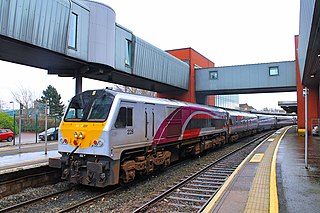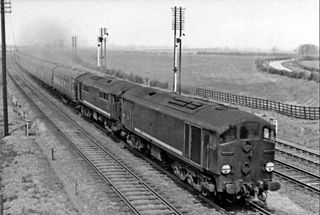
A diesel locomotive is a type of railway locomotive in which the power source is a diesel engine. Several types of diesel locomotives have been developed, differing mainly in the means by which mechanical power is conveyed to the driving wheels. The most common are diesel-electric locomotives and diesel-hydraulic.

The Córas Iompair Éireann 001 Class locomotive was manufactured by Metropolitan-Vickers at their Dukinfield Works in Manchester. The 001 Class locomotive was the backbone of mainline passenger and freight train services on the Irish railway network for forty years from 1955 until the mid-1990s when they were replaced by the new 201 Class.

The Córas Iompair Éireann 113 class locomotives were the first mainline diesel locomotives used in Ireland, being built in January 1950 and October 1951 by CIÉ at their Inchicore Works. They were fitted with Sulzer 6LDA28 engines of 915 hp (682 kW), with four Metropolitan-Vickers MV157 traction motors. They were of Bo-Bo wheel arrangement, weighed 80 tonnes and had a maximum speed of 90 km/h (56 mph). They were initially numbered 1100–1101 in the steam locomotive number series, but were subsequently renumbered B113–B114 in 1957.

The Córas Iompair Éireann 101 Class locomotives, numbered B101-B112, were built in 1956 by the Birmingham Railway Carriage and Wagon Company. They were fitted with Sulzer 6LDA28 engines of 960 hp (720 kW), with four Metropolitan-Vickers MV137 traction motors. They were of A1A-A1A wheel arrangement, weighed 75 tonnes and had a maximum speed of 120 km/h (75 mph).

The Córas Iompair Éireann 201 Class was a class of 34 diesel electric locomotives manufactured by Metropolitan-Vickers at their Dukinfield Works in Manchester. They were a smaller, lighter and less powerful version of the 001 Class and were originally intended for branch line passenger and freight duties. They were introduced in 1956 and, although their duties changed over the years, were in regular service on the Irish railway network until the mid-1980s. Six were sold to Northern Ireland Railways (NIR) in 1986.

The Iarnród Éireann (IÉ) / Northern Ireland Railways 201 Class locomotives are the newest and most powerful diesel locomotives operating in Ireland and were built between 1994 and 1995 by General Motors Diesel. They are model type JT42HCW, fitted with an EMD 12-710G3B engine of 3,200 hp (2,400 kW), weigh 108.862 tonnes and have a maximum speed of 164 km/h (102 mph).

The Córas Iompair Éireann 121 Class was a railway locomotive which was manufactured by General Motors Electro-Motive Division. These locomotives were in regular service on the Irish railway network until 2002, with the last two remaining in service until early 2008.

The CIE 141 Class locomotives were built in 1962 by General Motors Electro Motive Division (EMD) in the United States. Numbered B141 to B177, they were an updated version of the 121 Class locomotives, mechanically very similar but with cabs at each end.

The British Rail Class 28 diesel-electric locomotives, known variously as 'Metrovicks', 'Crossleys' or 'Co-Bos', were built under the Pilot Scheme for diesel locomotives as part of the British Railways 1955 Modernisation Plan.

The Electro-Motive Diesel (EMD) Class 66 are Co-Co diesel locomotives built by EMD for the European heavy freight market. Designed for use in Great Britain as the British Rail Class 66, a development of the Class 59, they have been adapted and certified for use in other European countries. Outside Europe, 40 locomotives have been sold to Egyptian Railways for passenger operation.
Push–pull is a configuration for locomotive-hauled trains, allowing them to be driven from either end of the train, whether having a locomotive at each end or not.

The Railway Preservation Society of Ireland (RPSI) is a railway preservation group founded in 1964 and operating throughout Ireland. Mainline steam train railtours are operated from Dublin, while short train rides are operated up and down the platform at Whitehead, County Antrim, and as of 2023, the group sometimes operates mainline trains in Northern Ireland using hired-in NIR diesel trains from Belfast. The RPSI has bases in Dublin and Whitehead, with the latter having a museum. The society owns heritage wagons, carriages, steam engines, diesel locomotives and metal-bodied carriages suitable for mainline use.

The Indian locomotive class WDM-2 is a class of diesel-electric locomotive that was developed in 1962 by American Locomotive Company (ALCO) for Indian Railways. The model name stands for broad gauge (W), Diesel (D), Mixed traffic (M) engine, 2nd generation (2). They entered service in 1962. A total of more than 2,700 WDM-2 was built at ALCO and Banaras Locomotive Works, Varanasi between 1962 and 1998, which made them the most numerous class of mainline diesel locomotive until its successor the WDM-3A.

The Indian locomotive class WDP-4 is a passenger-hauling diesel-electric locomotive with AC electric transmission designed by General Motors Electro-Motive Division and built by both GM-EMD and under license by Banaras Locomotive Works (BLW) of Varanasi, India for Indian Railways as the classes WDP4, WDP4B and WDP4D. The GT46PAC is a passenger version of the previous Indian Railways EMD GT46MAC freight locomotive. The locomotive has a 16-cylinder 710G3B diesel engine and is one of the fastest diesel-electric locomotives in service in Indian Railways.
The ALCO DL560C is a series of diesel-electric locomotive with AC electric transmission designed by the American Locomotive Company and produced under license by Banaras Locomotive Works (BLW) Varanasi, India for Indian Railways as their classes WDM-2, WDM-3A/2C, WDM-3D and WDG-3A for operation in India. The locomotive is fitted with a 16-cylinder ALCO 251 B, C diesel engine. In the early 1960s Indian Railways needed a reliable diesel workhorse to gradually replace its steam locomotive fleet. Equal numbers of ALCO's DL560C and EMD's G16 were chosen for trials. More locomotives of each of these were purchased for more trials. Indian Railways was keen on producing these locomotives in the country rather than depending on imports. EMD did not agree for a Transfer-of-Technology, while ALCO did. Thus ALCO DL560C was chosen for the job due to its easy maintenance, reliability and simple operation. And from then on vast numbers of this loco in different configurations have been produced and remain the main diesel traction power of Indian Railways.

The EMD G16 is a diesel locomotive built by General Motors in the US and under licence by Clyde Engineering in Australia and MACOSA in Spain. It has been used in Australia, Brazil, Egyptian Railways, Hong Kong, Israel Railways, Mexico, Spain, Yugoslav Railways and on the successor Croatian Railways, Slovenian Railways, Serbian Railways, Macedonian Railways, Republika Srpska Railways, Kosovo Railways and Railways of the Federation of Bosnia and Herzegovina.

The WAGR X class is a now-withdrawn class of diesel locomotives built by Beyer, Peacock & Company and Metropolitan-Vickers, Bowesfield Works, Stockton-on-Tees for the Western Australian Government Railways (WAGR) between 1954 and 1956. Several members of the class have been preserved.

The Córas Iompair Éireann (CIÉ) 2600 Class were Associated Equipment Company (AEC)–engined diesel multiple units that operated InterCity and suburban services on the CIÉ system between 1952 and 1975. Many were later converted for push–pull operation with diesel locomotives, finally being withdrawn when displaced by the electric Dublin Area Rapid Transit service in the mid-1980s.

The Spoornet Class 39-000 of 2006 is a South African diesel-electric locomotive from the Spoornet era.

The Córas Iompair Éireann/Iarnród Éireann 071 Class or Northern Ireland Railways 110 Class or Serbian Railways JŽ series 666 is a General Motors Electro-Motive Division EMD JT22CW series diesel-electric locomotive used in the Republic of Ireland, Northern Ireland and Serbia.




























